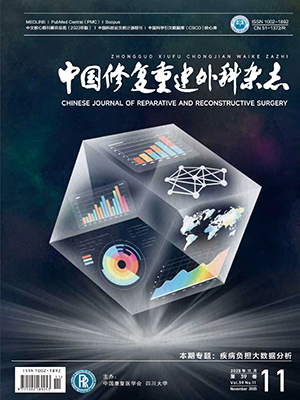Objective To investigate the effect of repeated freezing and thawing combining nuclease treatment on the decellularization of bovine tendons, and the morphology, structure, biochemical compositions, and mechanical properties of the decellularized tendons. Methods A total of 48 fresh 1-day-old bovine Achilles tendons were randomly divided into 3 groups (n=16): fresh normal tendons (group A), repeated freezing and thawing for 5 times (liquid nitrogen refrigeration/37℃ thawing, group B), and repeated freezing and thawing combining nuclease processing for 24 hours (group C). In each group, 2 tendons were used for scanning electron microscope (SEM), 3 tendons for histological and immunohistochemical observations, 3 tendons for DNA content detection, and 8 tendons for biomechanical testing. Results SEM observation indicated the intact, aligned, and densely packed collagen fibers with no disruption in groups A and B, and the slightly loose collagen fibers with little disruption in group C. The alcian blue staining, sirius red staining, and immunohistochemical staining showed that the most of glycosaminoglycan, collagen type I, collagen type III, and fibronectin in group C were retained after decellularization treatment. HE and DAPI staining showed that the cell nuclei between the collagen fibers were clearly visible in groups A and B; however, the cell nuclei between collagen fibers almost were invisible with a few residual nuclei on the endotendineum in group C. DNA quantitative detection confirmed that DNA content in group C [(0.05 ± 0.02) μg/mg] was significantly lower than those in group A [(0.24 ± 0.12) μg/mg] and group B [(0.16 ± 0.07) μg/mg] (P lt; 0.05). Biomechanical testing showed that the values of tensile strength, failure strain, stiffness, and elastic modulus were different among 3 groups, but no significant difference was found (P gt; 0.05). Conclusion Repeated freezing and thawing combining nuclease processing can effectively remove the component of cells, and simultaneously retain the original collagen fibrous structure, morphology, most of the extracellular matrix compositions, and mechanical properties of the bovine tendons.
Citation: JIANG Yanlin,ZHANG Yi,YANG Jieliang,LUO Jingcong,QIN Tingwu. HISTOMORPHOLOGICAL AND BIOMECHANICAL CHARACTERISTICS OF DECELLULARIZED BOVINE TENDONS. Chinese Journal of Reparative and Reconstructive Surgery, 2013, 27(5): 565-570. doi: 10.7507/1002-1892.20130125 Copy
Copyright ? the editorial department of Chinese Journal of Reparative and Reconstructive Surgery of West China Medical Publisher. All rights reserved




